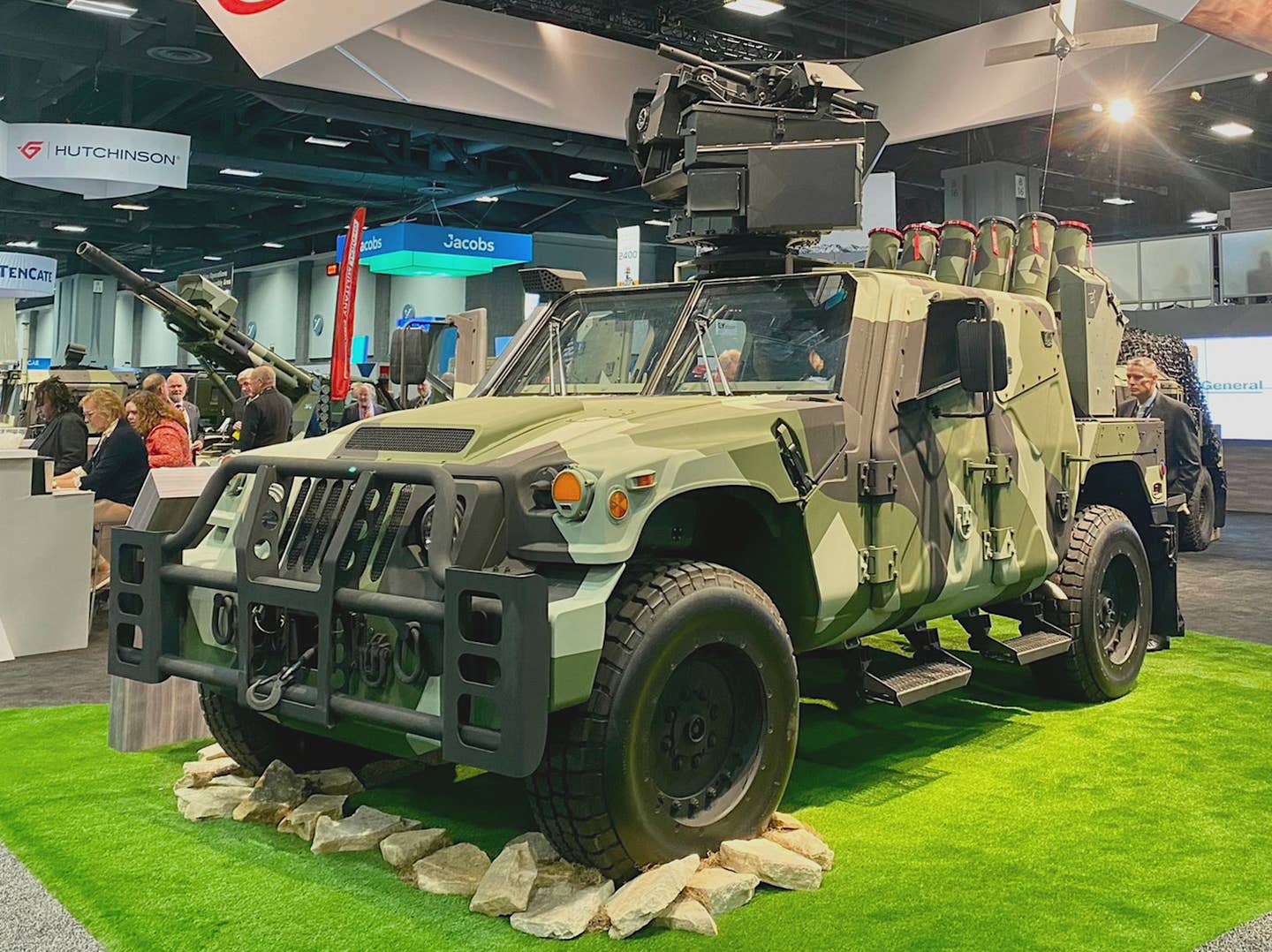AM General unveiled a HUMVEE concept with kamikaze drones and a counter-drone system at the Association of the US Army’s annual convention this year.
The auto manufacturer has developed the Blade Edition of its HUMVEE Saber vehicle in collaboration with drone maker AeroVironment and remote weapon station manufacturer Hornet Defense. The HUMVEE Saber is based on the proven and battle-tested HUMVEE vehicle platform.

The new vehicle boasts improved survivability with 360-degree kinetic and blast protection, particularly against mines, improvised explosive devices (IEDs), powertrain, suspension, and other improvements over standard Humvees.
The HUMVEE Saber Blade Edition
The Blade Edition of its HUMVEE Saber features an array of launchers at the rear for AeroVironment’s Switchblade 300 and Switchblade 600 loitering munitions, together with a Hornet Air Guard Remote Controlled Weapon System (RCWS) turret at the top of the vehicle.
The vehicle can be loaded with 10 Switchblade 600 loitering munitions in individual launch tubes and four Switchblade 300s in specially designed cells, two on either side of the launcher assembly.
The Switchblade 300 weighs 2.5 kilograms, including the warhead; it has a range of 10 kilometers and an endurance of 15 minutes. It can be used for pinpoint strikes against enemy personnel.

While the Switchblade 600 variant has a range of 40 kilometers, it weighs 54.4 kilograms and is equipped with a dual electro-optical and infrared sensor suite. With an endurance of 40 minutes, it can be used against larger, hardened targets via an anti-armor warhead and does not need external surveillance or fire assets.
Both Switchblade types are equipped with an electro-optical and infrared camera, and their operators on the ground can view the live video feeds captured by these cameras via a tablet-like controller.
These drones can be employed for surveillance and reconnaissance purposes and can be used to immediately strike targets that may emerge, in addition to striking the already known targets.
Switchblade munitions have a remarkable feature called “waved off” capability, which allows for the prevention of collateral damage. For example, if the situation changes after launch, it can engage a secondary target or destroy itself without inflicting casualties or property damage.
According to AeroVironment, the weapon can be waved off up to two seconds before the impact.
The Switchblade 600 also has the ‘recommit’ capability in addition to ‘wave-off,’ allowing the drone operators to abort the mission at any time and re-engage either the same or other targets multiple times.
Furthermore, AeroVironment has plans to add increased autonomy to the Switchblade series in the future, which will include the potential for groups of these drones to be used for swarming attacks that will cover more ground quickly and overwhelm enemy air defenses.
The Air Guard RCWS features electro-optical and infrared cameras, a small radar, and a 40-millimeter Heckler & Koch GMG automatic grenade launcher with air-bursting ammunition designed primarily against unmanned aerial vehicles (UAVs).

According to Hornet, the turret has an independent drone detection ring capable of automatically warning the operator if a drone is detected, which can then be verified visually and engaged.
“With the HUMVEE Saber Blade Edition, we continue to push the boundaries of lethality and protection on the battlefield, and we’re proud of the collective effort we fostered with AeroVironment and Hornet to bring this concept to life,” said John Chadbourne, AM General EVP – Chief Business Development Officer.
Tactical Vehicle With Offensive And Defensive Drone Capabilities Could Be A Game Changer
Notably, both AM General’s Humvees and AeroVironment’s Switchblade drones are used by Ukraine in its war effort against the invading Russian military. The Switchblade drones have come under the spotlight because of the war in Ukraine.
This is a blockbuster, but this is not a movie. This is the reality of our soldiers.
Ukrainian Humvees are racing ahead under a russian barrage in the Kherson region.
Only the sea can stop them.
Video by 59th Motorized Brigade. pic.twitter.com/nMw9R9wjAH— Defense of Ukraine (@DefenceU) October 6, 2022
Loitering munitions have become a common theme among the drone capabilities sought by the armed forces of several countries, particularly after the onset of the Russia-Ukraine War, where kamikaze drones, especially the American-made Switchblade loitering munitions, are pretty favored.
Video of a Ukrainian Switchblade 300 loitering munition strike on a Russian border checkpoint in Troebortnoe, Bryansk Oblast from today. https://t.co/hUECWJsQorhttps://t.co/ODZMgovJuhhttps://t.co/RA0jmSrPDl pic.twitter.com/GYvf7F8s2c
— Rob Lee (@RALee85) July 26, 2022
However, having a tactical vehicle armed with loitering munitions and counter-drone capabilities all in one could be a game changer on the modern battlefield.
Jean Boy, Managing Director of Hornet, explained that the current conflicts had demonstrated the increasing importance of drones targeting vehicles or reconnaissance missions.
“Being able to detect and defeat such threats while maintaining the vehicle’s primary protective capacity is the ultimate capability for a Remote Control Weapon Station. That’s Hornet Air Guard ambition,” Boy said.
- Contact the author at tanmaykadam700@gmail.com
- Follow EurAsian Times on Google News




